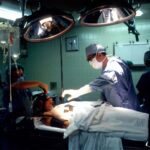Kupffer cells occupy a crucial position at the nexus of sensing the local metabolic and immune environment and triggering critical signals to stimulate repair. The deleterious role of hepatocyte-derived proinflammatory mediators in chronic ethanol liver injury has been illustrated. At the same time, the protective effects of hepatoprotective cytokines are demonstrated in models of partial hepatectomy and carbon tetrachloride-induced hepatotoxicity.
Structure
Kupffer cells (Browicz-Kupffer cells) are specialized macrophages in the liver sinusoids. They are attached to sinusoidal endothelial cells in each hepatic lobule’s periportal and centrilobular regions. Depending on their location, kupffer cells structure and function can differ. For example, periportal Kupffer cells tend to have more lysosomal enzyme and phagocytic activity, while centrilobular Kupffer cells create more superoxide radicals. They are amoeboid in shape, with surface features such as microvilli and pseudopodia that project in every direction. Their nucleus is indented and oval, and they can be lobulated.
They are the first immune cells to come in contact with gut bacteria, bacterial endotoxins, and microbial debris that enter the liver from the gastrointestinal tract. This explains why they are sometimes called the “first immune cells of the liver.” Any change in the functioning of the Kupffer cell will directly affect hepatocyte proliferation and hepatic fibrosis.
The primary role of the Kupffer cell is to phagocytose blood-borne materials that pass through the sinusoids from the portal vein and hepatic artery. They are also involved in the production of inflammatory cytokines and chemokines. These cytokines are mainly triggered by the interaction between PAMPs and DAMPs with receptors. For example, TLR4 and anaphylatoxin receptors activate macrophages to express inflammatory cytokines such as TNF-.
Function
As blood enters the liver from the gastrointestinal tract, it passes through the sinusoids (microscopic channels within the liver parenchyma) lined by star-shaped tissue macrophages called Kupffer cells. These macrophages perform a particulate filtration system, ensuring that few bacteria pass into the general circulation. Kupffer cells also release various inflammatory mediators, including eicosanoids, nitric oxide, and reactive oxygen species.
These cell-derived molecules regulate the innate immune response in standard and disease states. In normal liver, hepatic sinusoids are surrounded by Kupffer cells that exhibit what has been described as a “tolerogenic” phenotype to limit unwanted antigen-driven immune responses.
When exposed to pathogenic hepatitis viruses or toxins, Kupffer cells shift to a more activated state, characterized by their ability to present antigens to CD8+ T cells and attract inflammatory monocytes via chemokines such as MIP-2. They also secrete the anti-inflammatory cytokine IL-10, which downregulates proinflammatory cytokines.
Unlike conventional monocyte-derived macrophages, which have no proliferative potential, Kupffer cells can self-renew. This difference may reflect that Kupffer cells are derived from yolk sac-derived mononuclear precursor cells rather than hematopoietic stem cells (HSCs) in the bone marrow. It is also intriguing that irradiation of host mice followed by transplantation of donor bone marrow does not reconstitute Kupffer cells, but T cells and B cells are fully reconstituted.
Receptors
The scavenger receptors on Kupffer cells detect and ingest protein complexes, small particles, senescent red blood cells, and cell debris. This phagocytosis is accomplished within seconds. This clears the gastrointestinal tract from microbial invaders and prevents bacteria from entering the general circulation.
The Kupffer cells also perform primary immune surveillance against gut-derived toxins, lipopolysaccharide (LPS), and pathogens. They uptake LPS and trigger a TLR-MyD88-NFkB axis, which produces IL-12 and subsequently activates dense granulomas of macrophages in the liver.
These monocyte-derived macrophages are specialized to be immunogenic or tolerogenic. Immunogenic macrophages recognize antigens and release proinflammatory cytokines and chemokines, while tolerogenic macrophages downregulate inflammatory responses by ingesting apoptotic neutrophils.
The development of hepatic macrophages starts in the yolk sac, where they differentiate into fetal macrophages. When these macrophages enter the bloodstream, they migrate to the fetal liver and mature into Kupffer cells. The maturation process varies depending on the location of the macrophages in the hepatic zone. For example, Kupffer cells in the periportal region experience direct contact with the blood flow and have more excellent phagocytic activity than those in the centrilobular area. These macrophages also recycle hemoglobin by destroying senescent red blood cells through phagocytic action, then conjugating the iron-containing portion to form bilirubin, which is secreted into the bile.
Signaling
Kupffer cells are the liver’s primary source of inflammatory cytokines and chemokines. They secrete IL-12, IL-18, TNF-a, and other cytokines promoting hepatic fibrosis. They also initiate pathogenic intrasinusoidal thrombosis in collaboration with sinusoidal endothelial cells and activate the hepatic macrophage proinflammatory phenotype via the production of matrix metalloproteinases, platelet-derived growth factor, and reactive oxygen species. In addition, they participate in LPS sensitization and contribute to the progression of metabolic liver diseases, including ALD and NASH, by regulating hepatic lipid metabolism.
Kupffer cell function depends on its natural immune environment and exhibits excellent adaptability. It can shift between the tolerogenic phenotype and a pathologically activated state in response to disease conditions such as viral or nonviral hepatitis, alcoholic hepatitis, steatohepatitis, and inflammation or rejection of the liver in organ transplantation.
They are star-shaped macrophages that occupy the lining of the liver sinusoids (microscopic blood channels) and are phagocytic. They can be found attached to sinusoidal endothelial cells in the hepatic lobules’ periportal and centrilobular regions. Depending on their location, their phagocytic capacity and secretory activity differ, with periportal Kupffer cells being more specialized in a lysosomal enzyme and superoxide release.




